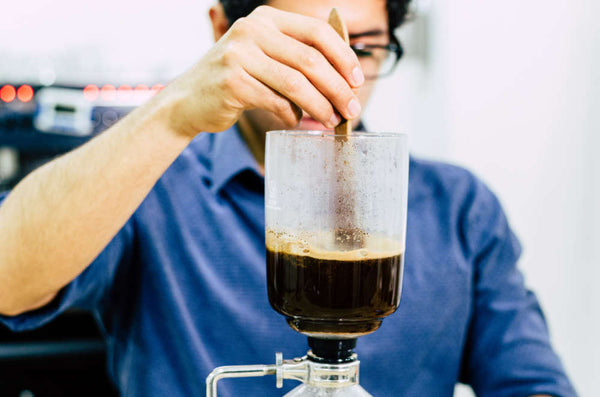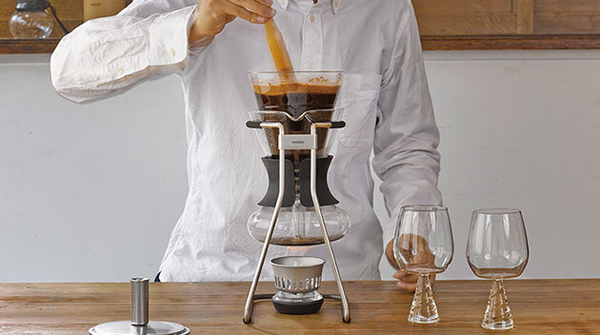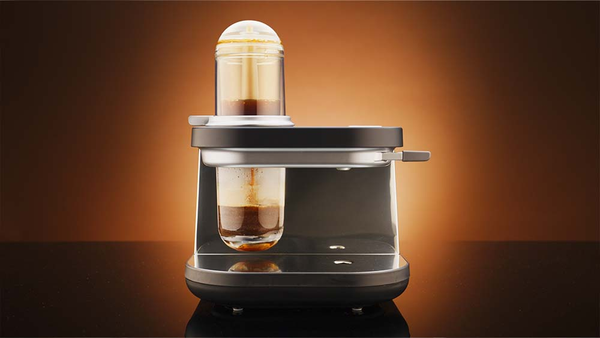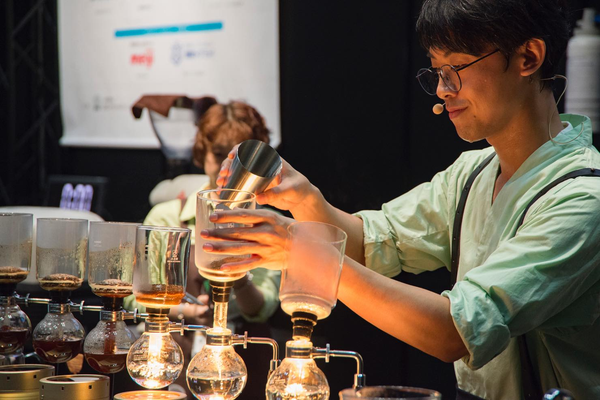Brewing coffee in it is almost like a scientific experiment! Did you know that this interesting device has been around for nearly two centuries?
With its laboratory-like design, the siphon is an extraordinary coffee brewer that uses a combination of steam pressure and gravity to concoct your caffeinated beverage. It consists of two chambers for preparing your favorite drink quickly and conveniently.
By combining both immersion and filter brewing, you can enjoy a robust cup of coffee that is incredibly smooth. The siphon promotes distinct flavors from all facets of the beans - making it an ideal choice for those looking to savor every sip! This unique technique in crafting coffee has been popularized in Japan as well as many other countries across Asia.
Through this article, you will discover the origins of this appliance, understand its operating principle, and become familiar with the fundamental principles for making coffee in a siphon.
Device and principle of operation
The Siphon is an innovative coffee-making device comprising two chambers. Boiling water rises due to pressure from the lower chamber, which has been heated either with alcohol or a gas burner. This carries the hot liquid into the upper container where it mixes with ground coffee, forming a delicious brew. When the heat source is removed and reduced pressure causes gravity to take its course – brewed beverage flows back down in moments - leaving thick remains on top filter in exchange for full-bodied goodness below!
The siphon uses pressurized water vapor to brew coffee.
History of occurrence
In 1841, Madame Vassier revolutionized the way we use siphons today with her invention of the first modern-day version. It didn't take long for this tool to become commonplace.
Introducing the mesmerizing balancing siphon! Its distinguishing feature is that it can extinguish its flame, two chambers of this amazing device are set beside each other. Inevitably, when water is transferred from one tank to another, a weighing system starts up due to the difference in weight which causes the lights to turn off abruptly. Its awe-inspiring power and brilliance never cease to amaze me!
At the turn of the century, siphon designs from Massachusetts housewives Anne Bridges and Mrs. Sutton made their way to America, however, it wasn't until two decades later that they began production in the US. In 1915, Silex was introduced as a new type of model built with Pyrex glass - an advancement that eliminated brittleness issues thus allowing for greater commercial appeal.
The coffee world has seen a plethora of siphons emerge since then, with Hario devices being the most favored in Japan and Taiwan. In particular, the Sommelier model is both convenient and stylish, it contains two filters – metal and fabric – which offer more creative avenues for brewed coffee tasting.
The Hario Sommelier is designed to replicate a wine carafe, allowing you to savor the delightful scent of your coffee. © global.hario.com
KitchenAid recently released an automatic siphon that features a built-in electrical heat source, as opposed to the standard gas or alcohol burners. This model also stands out in its design with magnetic seals replacing gaskets at the device's juncture and a reusable mesh filter as well as stainless steel tubing - both more dependable than their glass counterparts. To date, it has become one of the most sought-after innovations on the market!
The recent introduction of the Siphonysta electric siphon from Tiger Corporation has revolutionized traditional coffee-making. This unique apparatus features two bowls, an inversion to the classic setup, instead of adding water first and then introducing ground beans, you pour your freshly grounded coffee into the lower chamber before heating up water in its upper counterpart. Through pressure created by steam, the hot liquid rapidly cascades down, extracting every bit of flavor out of beans before filtering back into its initial bowl.
By merging classic siphon mechanics with cutting-edge design and user-friendliness, Siphonysta offers an incomparable experience.© tiger-corporation-us.com
Although the aesthetic of each device may vary, they all operate according to a similar set of principles- and we'll get into that further.
How to make coffee in a siphon
Crafting the perfect cup of coffee is an uncomplicated process that requires only a few steps - but don't let its simplicity fool you. The ratio between coffee and water employed in siphon brewing generally lies at 1:15, however, this may differ depending on the size of your machine.
- Securely fix the filter at the base of the upper chamber and attach it to the bottom part of your glass tube for a complete siphon.
- Stream hot water into the lower container for a speedy drink-making process.
- Ignite the burner and position it beneath the lower flask.
- Insert the extender of the upper flask into the throat of its companion below.
- To create the perfect cup of coffee, you'll need to grind your beans more finely than for drip brewing but coarser than for a geyser.
- When the majority of the liquid has shifted from the bottom flask to the top, it's time to lower your stovetop heat.
- Pour coffee into the water and stir gently.
- Leave for about a minute.
- Turn off the burner. The coffee will drop into the lower flask.
- Detach the lid and allow your beverage to cool.
In Japan, the drink is stirred twice with a bamboo spatula. Initially, this creates a whirlpool effect and makes sure that the water evenly wets all of the coffee grounds. After adding them to the upper chamber of water, it's then time for another stirring - usually gentler than before - for optimal degassing results. According to Narumi Sato, CEO of Belleville Japan, an indication of expertise in this area would be forming a dome-like shape at the base layer composed solely out of coffee grounds.
For coffee connoisseurs, the taste of coffee from a siphon is unparalleled. This brewing technique utilizes immersion to ensure that ground coffee remains in touch with water during extraction, as a result, you will enjoy an exquisitely structured and flavorful cup of coffee!
Siphon coffee is an iconic and renowned method of immersion brewing that yields a dense yet bright cup with exceptional clarity. For those seeking the perfect balance between strength, flavor, and vibrancy, this method stands out from the rest.
No matter the roast or variety, any coffee is ideal for this brewing method. Plus, a fabric or metal filter will make your brew taste more intense - both filters let through more oils than those made of paper do.
Siphon Coffee Championships
In 2003, Japan pioneered the worldwide Siphon Coffee Brewing Championship based on the model of the prestigious World Barista Championship (WBC).
Every year, the Specialty Coffee Association of Japan (SCAJ) hosts a championship that is open to any barista keen on taking part. During this competition, participants will have 15 minutes to make 3 drinks in a siphon and also create their unique signature beverage. The champion earns the privilege of representing Japan in the world championship event!
In 2009, the World Siphon Coffee Championships ignited from Japan's fruitful results in coffee-making competitions and immediately secured its spot as a beacon of excellence for all coffee aficionados.
The World Siphonist Championship is eager to provide seminars on crafting coffee in a siphon, aiming to make this method more well-known and celebrated. © worldsiphonistchampionship.org
In 2021, the World Championship will only permit one representative from each organization with an official license granted by the Secretariat for their respective country or region. Accordingly, Australia, Korea, Malaysia, Singapore, USA, and China are eligible to participate- as well as Hong Kong, Taiwan, and Macau individually.
In 2018, 8 ambitious competitors joined forces for the ultimate goal of achieving victory at the championship. After a grueling race, Kasama Kunbun from Thailand emerged victorious with Wei-Shin Chang from Taiwan and Regin Wai from Malaysia earning second and third place respectively. The next competition is scheduled to take place in autumn 2023 in Japan - will you be there?
Conclusion
Although the siphon isn't a novel invention, it doesn't typically enjoy the same widespread popularity as other coffee brewing methods. The use of this apparatus is especially prevalent in Japan - home to one of its biggest producers, Hario.
The art of making coffee in a siphon is straightforward yet captivating, and the result is thick and vibrant. Those who enjoy experimenting with coffee ought to give this device a try to truly savor an exquisite cup.





